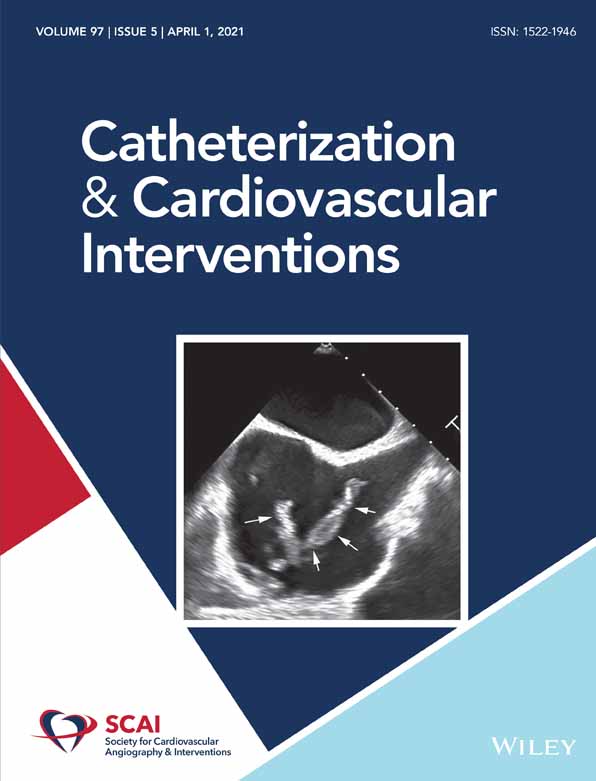Hybrid approach to postmyocardial infarction ventricular septal defect repair
Ali A. Alsaad MD
Department of Medicine/Cardiology, NorthShore University HealthSystem, Evanston, Illinois, USA
Search for more papers by this authorHyde M. Russell MD
Department of Cardiothoracic Surgery, NorthShore University HealthSystem, Evanston, Illinois, USA
Search for more papers by this authorArthur J. Tokarczyk MD
Department of Anesthesiology, NorthShore University HealthSystem, Evanston, Illinois, USA
Search for more papers by this authorCorresponding Author
Mark J. Ricciardi MD
Department of Medicine/Cardiology, NorthShore University HealthSystem, Evanston, Illinois, USA
Correspondence
Mark J. Ricciardi, Division of Cardiology, NorthShore University HealthSystem, Evanston, IL 60201.
Email: [email protected]
Search for more papers by this authorAli A. Alsaad MD
Department of Medicine/Cardiology, NorthShore University HealthSystem, Evanston, Illinois, USA
Search for more papers by this authorHyde M. Russell MD
Department of Cardiothoracic Surgery, NorthShore University HealthSystem, Evanston, Illinois, USA
Search for more papers by this authorArthur J. Tokarczyk MD
Department of Anesthesiology, NorthShore University HealthSystem, Evanston, Illinois, USA
Search for more papers by this authorCorresponding Author
Mark J. Ricciardi MD
Department of Medicine/Cardiology, NorthShore University HealthSystem, Evanston, Illinois, USA
Correspondence
Mark J. Ricciardi, Division of Cardiology, NorthShore University HealthSystem, Evanston, IL 60201.
Email: [email protected]
Search for more papers by this authorAbstract
Postinfarction ventricular septal rupture is a rare and devastating complication of myocardial infarction. Despite attempts at acute surgical and percutaneous defect closure, morbidity and mortality remain high. Herein, we describe a hybrid surgical and catheter-based approach to defect closure in a 63-year-old woman with postinfarction ventricular septal rupture and cardiogenic shock.
CONFLICT OF INTEREST
The authors declare no conflicts of interest.
Supporting Information
| Filename | Description |
|---|---|
| ccd29000-sup-0001-VideoS1.avivideo/avi, 5.8 MB | Video S1 Ventriculography during the initial presentation with ST-elevation myocardial infarction showing contrast filling the right ventricle and the pulmonary artery suggestive of ventricular septal rupture. |
| ccd29000-sup-0002-VideoS2.avivideo/avi, 2.4 MB | Video S2 Transthoracic echocardiogram parasternal short axis view showing the ventricular septal defect with color Doppler left-to-right flow. |
| ccd29000-sup-0003-VideoS3.avivideo/avi, 3.8 MB | Video S3 Transesophageal echocardiogram mid esophageal four chamber view showing the ventricular septal defect with color Doppler left-to-right flow. |
| ccd29000-sup-0004-VideoS4.avivideo/avi, 3.5 MB | Video S4 Transesophageal echocardiogram transgastric short axis view showing the ventricular septal defect with color Doppler left-to-right flow. The defect measuring nearly 10 mm. |
| ccd29000-sup-0005-VideoS5.avivideo/avi, 4.5 MB | Video S5 Transesophageal echocardiogram mid esophageal four chamber view showing the device sheath through the ventricular septal defect and the device left ventricular-disc deployed and being pulled toward the interventricular septum. |
| ccd29000-sup-0006-VideoS6.avivideo/avi, 3.2 MB | Video S6 Intraoperative transesophageal echocardiogram mid esophageal four chamber view showing the occlude device well situated on the ventricular septal defect. Color Doppler showing minimal residual shunt. |
Please note: The publisher is not responsible for the content or functionality of any supporting information supplied by the authors. Any queries (other than missing content) should be directed to the corresponding author for the article.
REFERENCES
- 1Jones BM, Kapadia SR, Smedira NG, et al. Ventricular septal rupture complicating acute myocardial infarction: a contemporary review. Eur Heart J. 2014; 35(31): 2060-2068.
- 2Antman EM, Anbe DT, Armstrong PW, et al. ACC/AHA guidelines for the management of patients with ST-elevation myocardial infarction—executive summary. A report of the American College of Cardiology/American Heart Association Task Force on Practice Guidelines (Writing Committee to revise the 1999 guidelines for the management of patients with acute myocardial infarction). J Am Coll Cardiol. 2004; 44(3): 671-719.
- 3O'Gara PT, Kushner FG, Ascheim DD, et al. 2013 ACCF/AHA guideline for the management of ST-elevation myocardial infarction: a report of the American College of Cardiology Foundation/American Heart Association Task Force on Practice Guidelines. Circulation. 2013; 127(4): e362-e425.
- 4Cinteza EE, Butera G. Complex ventricular septal defects. Update on percutaneous closure. Rom J Morphol Embryol. 2016; 57(4): 1195-1205.
- 5Lopes AA, Barst RJ, Haworth SG, et al. Repair of congenital heart disease with associated pulmonary hypertension in children: what are the minimal investigative procedures? Consensus statement from the Congenital Heart Disease and Pediatric Task Forces, Pulmonary Vascular Research Institute (PVRI). Pulm Circ. 2014; 4(2): 330-341.
- 6Thiele H, Kaulfersch C, Daehnert I, et al. Immediate primary transcatheter closure of postinfarction ventricular septal defects. Eur Heart J. 2009; 30(1): 81-88.
- 7Rao PS, Harris AD. Recent advances in managing septal defects: ventricular septal defects and atrioventricular septal defects. F1000Res. 2018; 7(498): 1–16.
- 8Gray RG, Menon SC, Johnson JT, et al. Acute and midterm results following perventricular device closure of muscular ventricular septal defects: a multicenter PICES investigation. Catheter Cardiovasc Interv. 2017; 90(2): 281-289.
- 9Holoshitz N, Kenny D, Hijazi ZM. Hybrid interventional procedures in congenital heart disease. Methodist Debakey Cardiovasc J. 2014; 10(2): 93-98.
- 10 investigators G. An international randomized trial comparing four thrombolytic strategies for acute myocardial infarction. N Engl J Med. 1993; 329(10): 673-682.
- 11Faccini A, Butera G. Techniques, timing, and prognosis of Transcatheter post myocardial infarction ventricular Septal defect repair. Curr Cardiol Rep. 2019; 21(7): 59.
- 12Papalexopoulou N, Young CP, Attia RQ. What is the best timing of surgery in patients with post-infarct ventricular septal rupture? Interact Cardiovasc Thorac Surg. 2013; 16(2): 193-196.
- 13Takahashi H, Arif R, Almashhoor A, Ruhparwar A, Karck M, Kallenbach K. Long-term results after surgical treatment of postinfarction ventricular septal rupture. Eur J Cardiothorac Surg. 2015; 47(4): 720-724.
- 14Heckle MR, Brooksbank JA, Agarwal MA, Ibebuogu UN. Outcomes of early versus delayed transcatheter closure of post-myocardial infarction ventricular septal defect. Cardiovasc Revasc Med. 2020; 21(9): 1093-1096.
- 15Meng W, Lin K, Zhang E. Perventricular closure on the beating heart: an effective hybrid approach in managing a postinfarction apical ventricular septal defect. J Card Surg. 2013; 28(1): 16-18.
- 16Love BA, Whang B, Filsoufi F. Perventricular device closure of post-myocardial infarction ventricular septal defect on the beating heart. J Thorac Cardiovasc Surg. 2011; 142(1): 230-232.




